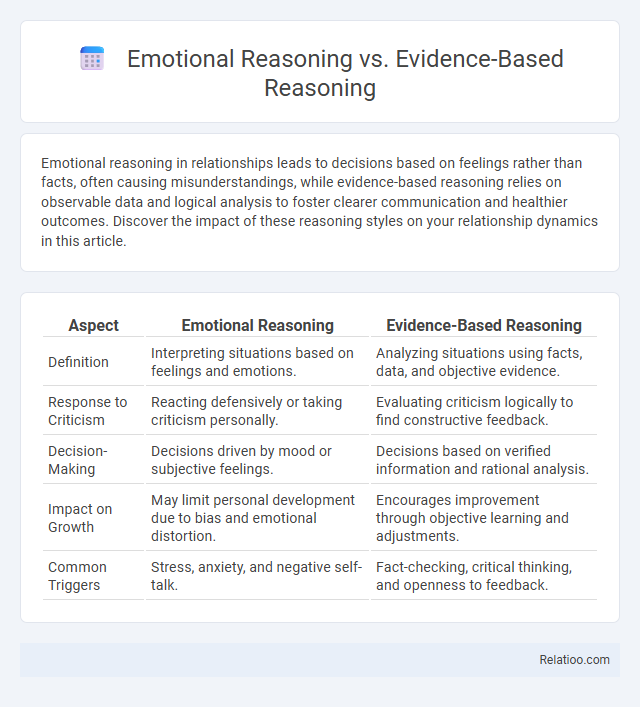Emotional reasoning in relationships leads to decisions based on feelings rather than facts, often causing misunderstandings, while evidence-based reasoning relies on observable data and logical analysis to foster clearer communication and healthier outcomes. Discover the impact of these reasoning styles on your relationship dynamics in this article.
Table of Comparison
| Aspect | Emotional Reasoning | Evidence-Based Reasoning |
|---|---|---|
| Definition | Interpreting situations based on feelings and emotions. | Analyzing situations using facts, data, and objective evidence. |
| Response to Criticism | Reacting defensively or taking criticism personally. | Evaluating criticism logically to find constructive feedback. |
| Decision-Making | Decisions driven by mood or subjective feelings. | Decisions based on verified information and rational analysis. |
| Impact on Growth | May limit personal development due to bias and emotional distortion. | Encourages improvement through objective learning and adjustments. |
| Common Triggers | Stress, anxiety, and negative self-talk. | Fact-checking, critical thinking, and openness to feedback. |
Introduction to Emotional Reasoning
Emotional reasoning involves interpreting situations based on your feelings rather than objective evidence, leading to conclusions that may not align with reality. This cognitive process often fuels cognitive distortions, such as catastrophizing or black-and-white thinking, causing you to misjudge events. Understanding the distinction between emotional reasoning and evidence-based reasoning helps you develop healthier thought patterns grounded in factual information.
Understanding Evidence-Based Reasoning
Evidence-based reasoning relies on objective data and factual information to form judgments, minimizing the influence of emotions or personal biases. In contrast, emotional reasoning interprets situations based on feelings rather than facts, often leading to distorted conclusions. Recognizing cognitive distortions--such as overgeneralization or catastrophizing--helps individuals differentiate emotional responses from evidence-based analysis, enhancing critical thinking and decision-making accuracy.
Key Differences Between Emotional and Evidence-Based Reasoning
Emotional reasoning relies on feelings to interpret reality, often leading to subjective conclusions influenced by mood and anxiety, while evidence-based reasoning depends on objective facts, data, and logical analysis to form conclusions. Cognitive distortions, such as catastrophizing or black-and-white thinking, amplify emotional reasoning by twisting perception and reinforcing erroneous beliefs. Key differences between emotional and evidence-based reasoning include the reliance on subjective feelings versus empirical evidence and the tendency of emotional reasoning to perpetuate biases, whereas evidence-based reasoning promotes critical thinking and accuracy.
Psychological Origins of Emotional Reasoning
Emotional reasoning originates from the brain's limbic system, where intense emotions override logical processing in the prefrontal cortex, leading individuals to interpret situations based on feelings rather than objective facts. This cognitive distortion often stems from early life experiences, attachment styles, and maladaptive neural pathways that reinforce automatic negative thought patterns. In contrast, evidence-based reasoning relies on evaluating external data and factual information, engaging higher-order cognitive functions to counterbalance emotional biases.
Benefits of Evidence-Based Reasoning
Evidence-based reasoning relies on objective data and factual information, allowing you to make decisions that are grounded in reality rather than emotional biases. This approach improves problem-solving accuracy by minimizing cognitive distortions such as catastrophizing or overgeneralization, which often skew perception. Utilizing evidence-based reasoning enhances clarity, promotes critical thinking, and leads to more reliable outcomes in both personal and professional contexts.
Cognitive Biases Influencing Emotional Reasoning
Cognitive biases such as confirmation bias and negativity bias significantly influence emotional reasoning by causing individuals to interpret situations based on subjective feelings rather than objective evidence. Emotional reasoning often distorts perceptions, leading to faulty conclusions unsupported by factual data, unlike evidence-based reasoning which relies on logical analysis and verified information. Understanding these cognitive distortions is essential to mitigate their impact and enhance decision-making accuracy.
Impact of Reasoning Styles on Decision Making
Emotional reasoning often leads you to make decisions based on feelings rather than facts, which can result in biased or impulsive outcomes. In contrast, evidence-based reasoning relies on objective data and logical analysis, promoting more rational and effective decision-making. Cognitive distortions distort your perception, causing errors in thinking that negatively affect judgment and increase vulnerability to poor decisions.
Common Pitfalls of Emotional Reasoning
Emotional reasoning often leads to cognitive distortions by causing individuals to interpret situations based on feelings rather than factual evidence, resulting in biased or inaccurate conclusions. This pitfall stems from prioritizing emotional responses over objective data, which can reinforce negative beliefs and hinder rational decision-making. In contrast, evidence-based reasoning relies on verifiable facts and logic, providing a more balanced and realistic assessment of situations.
Strategies to Shift from Emotional to Evidence-Based Reasoning
Shifting from emotional reasoning to evidence-based reasoning involves recognizing cognitive distortions, such as catastrophizing or overgeneralization, and actively challenging them with objective data and factual information. Strategies include mindfulness practices to increase awareness of emotional triggers, keeping a journal to document thoughts and corresponding evidence, and using structured techniques like cognitive restructuring to reframe irrational beliefs. Consistent application of these methods helps build cognitive flexibility, promoting logical analysis over emotional bias in decision-making.
Cultivating Balanced Reasoning for Better Outcomes
Emotional reasoning often leads to conclusions based solely on feelings rather than facts, while evidence-based reasoning relies on objective data and logical analysis to inform decisions. Cognitive distortions, such as catastrophizing or overgeneralization, can skew perceptions and hinder balanced judgment. Cultivating balanced reasoning involves recognizing emotional influences, critically evaluating evidence, and challenging cognitive distortions to improve decision-making and achieve better outcomes in personal and professional contexts.

Infographic: Emotional Reasoning vs Evidence-Based Reasoning
 relatioo.com
relatioo.com